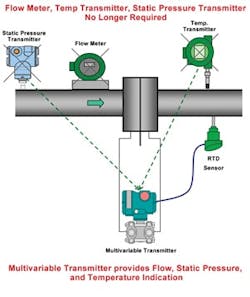Time to Hit the Multivariable Switch?
For our custom process skids we have to provide precise measurement of pressure, temperature and flow.
To this point we've not used multivariable transmitters, mostly because of our parts-stocking responsibility for our installed customer base.
Are there any practical reasons why we shouldn't switch? Cost, wiring and time all seem to favor a multivariable approach for new builds. The vendors we talked to suggest we're dumb not to switch.
—from June '10 Control Design
ANSWERS
Plus or Minus Accuracy
Before a monetary cost-benefit analysis is performed concerning the changeover, technical/system design specifics of your skid first must be considered.
In order to realize the benefits of a multivariable transmitter, the flow, temperature and static (gauge) measurements need to be referencing the same process fluid and located within close enough proximity to each other to be representative of the flow.
Remember, the multivariable is using those temperature, static and differential pressure measurements to calculate mass and/or volumetric flow.
Notice that I just introduced another type of measurement: the differential pressure (DP) measurement. Multivariable devices require that a restriction or DP-producing element be installed within the process line where the flow measurement is taken.
The need for remote or local indication and the need for smart—digital communications—instruments are additional issues of concern before switching devices.
If your skid currently provides only local indication of the three variables, then most multivariable transmitters can be programmed to display those same variables. If remote indication is required, then the transmitter's analog and digital electrical output signals can be used. The flow, static and temperature values can be read digitally via various communication protocols such as HART, Modbus or Foundation fieldbus depending on which choices are offered by the transmitter manufacturer and displayed on a controller, remote indicator or PLC.
Accuracy is the last variable to consider before changing. Most multivariable transmitters offer a minimum of +1.0% accuracy of flow rate at a specified turndown limit. Static pressure accuracies can approach +0.10% of span, with temperature measurement and display accuracies of +0.5 °C.
After considering the design-specific variables and weighing the cost of individual instruments against the costs associated with the multivariable transmitter, changing over might just give your skid's performance that extra edge. Actual improvements and cost savings could be realized and possibly passed along to your customer.
David Matherly
Field Instruments Business Unit
Yokogawa of America
www.yokogawa.com/us
Understand the Trade-Offs
We get this question quite often, and while our company offers both multivariable (MV) and dedicated devices for various parameters, there is no one answer or reason to suggest that a uniform solution applies to each and every case.
The real answer is that each situation needs to be evaluated individually. In come cases, a multivariable solution will work satisfactorily, if the performance meets all of the requirements. But what we often find is that if highly precise measurements are required, then the performance needed for each parameter must be reviewed, and then determine whether the MV unit can meet all of those requirements.
Many multivariable devices can adequately measure more than one parameter, but rarely do they perform each measurement as a best-in-class device.
If the user determines that the accuracy, repeatability and response of each parameter measured by an MV device are sufficient for the installation, then it can be considered as suitable for use.
However, if the specifications for each individual parameter are critical and the MV device does not meet those specifications, then individual devices must be used. So again, it depends on the requirement.
In addition, as with all purchases, the user should look beyond just the initial acquisition and installation costs and should consider the total lifecycle impact.
For example, in maintenance situations for the given process, if the multivariable device needs to be removed for servicing, calibration or replacement and a substitute device is not immediately available, can the operation still run without all of the measurements required? Whereas if a single variable device were removed, while the other devices were still operating, it may be possible to continue running the given process for a while and prevent downtime.
And when using an MV device, your supplier options are reduced, and options for replacement are limited when one of the measurement parameters is in question or fails. Then it's more difficult to troubleshoot that one measurement and, if needed, make an economical replacement for that individual parameter.
Another limiting factor to consider is when a new technology or innovation—say a new fast-response temperature sensor—comes along and you would like to consider implementation in your design to increase your machine's performance. In that case it is much more difficult to swap out that one sensor when it's been built into your MV transmitter. Thus, future flexibility is severely limited for your standard design and for your customer's ongoing improvements.
There are trade-offs, and each machine designer must determine what is most important to the process and take into consideration the end user's needs, as well. It's important to discuss all of the requirements with the supplier to get a recommendation on the best fit for any installation.
There also are several readily available online selection and sizing tools, which are a great place to start.
Jerry Spindler
OEM Business Development
Endress+Hauser
www.us.endress.com/oem


